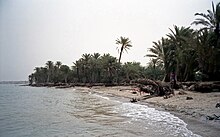Tihama
The Tihama ( Arabic تهامة Tihāma 'hot land') is a hot and humid desert that stretches on the Arabian Peninsula as a 60 km wide strip along the west and south coast from the Hejaz in Saudi Arabia via Asir to Yemen .
One differentiates:
- the coastal Tihama
Its climate is determined by the sea. The area is flat. Occasionally, salt domes protrude from the sediment material, forming peaks up to 150 meters high and supplying table salt in open-cast mining . Halophytes , mangroves and further inland grass-topped steppes form the natural vegetation. The rare rain falls in summer, mostly in the form of short but violent thunderstorms. Millet, corn and alfalfa form the basis of a modest agriculture. The coastal towns are mostly used for fishing, shipping and trade. - the dry Tihama, close to the mountains,
resembles an inclined embankment level 50 to 250 meters high. Materials are clastic and loose sediments such as silt , sand, gravel and crushed stone . Rainforest cultivation is possible here between May and September . On the terraced slopes, the fields are primarily supplied with water that comes from the mountains. At the foot of the mountains the cultivated land is most productive and the settlement most densely populated. Deep-rooted species such as umbrella acacias and doum palms occur naturally and sometimes form dense stands. - the mountain Tihama
It includes the deeply carved river valleys from the mountain foot to the valley valleys at an altitude of about 700 to 1000 meters. All year round flowing waters allow the cultivation of a wide variety of tropical products, which results in relatively dense settlement. Originally widespread and species-rich dry forests have now almost disappeared. Likewise, gallery forests along the wadis .
Overall, the Tihama is one of the hottest and humid areas on earth. It is characteristic that the temperatures show only slight day-night fluctuations and only weak air movement prevails.
The Tihama population shows influences from the not far away Horn of Africa : people of black African origin, some of whom are descendants of former slaves, unveiled and colorfully dressed women and typical round houses made of clay and straw.
One of the most important markets of the Tihama is that of Bayt al-Faqīh . Here traits of Ethiopian rule can be read that go back to the 5th and 6th centuries.
literature
- Walter Dostal (Ed.): Tribal societies of the southwest regions of the Kingdom of Saudi Arabia. Social anthropological studies (= Austrian Academy of Sciences. Philosophical-Historical Class. Meeting reports. Vol. 732 = Publications on social anthropology. Vol. 8). With contributions by Andre Gingrich , Johann Heiss and Josef Zötl. Publishing house of the Austrian Academy of Sciences, Vienna 2006, ISBN 3-7001-3598-X .
- GV Smith, YA Al-Mooji: Groundwater development in the Tihama coastal plain. In: Spate Irrigation. Proceedings of the Subregional Expert Consultation on Wadi Development for Agriculture in the Natural Yemen, 6-10 December 1987, Aden, PDR Yemen. Food and Agriculture Organization of the United Nations et al., Rome et al. 1989, pp. 151–161, digital version (PDF; 1.07 MB) .
Individual evidence
- ↑ Gerhard Heck, Manfred Wöbcke: Arabian Peninsula. DuMont-Reiseverlag, Ostfildern 2007, ISBN 978-3-7701-7643-4 .

